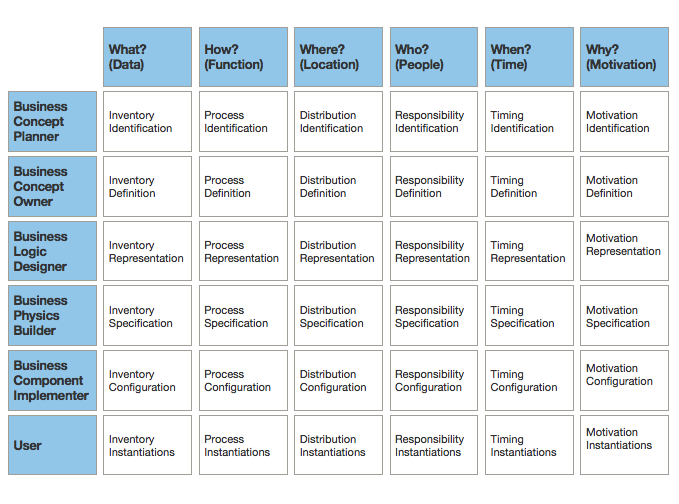The Zachman Framework is a visualization schema, which captures the whole EA using a predefined set of models [BBL12]. The models are organized in a matrix with the first dimension describing one particular aspect of an enterprise and the second dimension associating it with a certain stakeholder view [Inta].
Zachman Framework Foundations
The Zachman Framework is one of the first approaches to EAM [Buc10b][BBL12]. Basically, it is a schema for classifying and organizing a set of models/artifacts used to describe an entire enterprise architecture [Intb]. This schema is derived from other disciplines, namely architecture and engineering, where the organization of artifacts resulting from the production of complex physical products like buildings or airplanes was already explored [Intb]. The concept of the framework is illustrated in the 6x6 matrix represented in Figure 1.

Figure 1: Simplified Zachman Framework. [Based on: Zachman International. The Concise Definition of The Zachman Framework by: John A. Zachman. www.zachman.com/about-the-zachman-framework. Accessed: 29.10.2016.]
The rows of the matrix constitute the different perspectives of the EAM stakeholders [BBL12]. These stakeholders are the planner, the owner, the designer, the builder and the implementer of an enterprise as well as the enterprise itself [Inta]. Each of those views is of different nature, not just a representation of a different levels of abstraction of the enterprise [Zac87].
The columns of the matrix each describe disparate aspects of the enterprise [Zac87]. The possible aspects are described using key questions, more specifically the questions what? (data), where? (location), how? (function), who? (people), when? (time) and why? (motivation) [Inta]. Each of those aspects can stand alone even though they describe the same object [Zac87]. Also, the columns should be considered as being equal in importance [BBL12].
In the resulting matrix, each cell contains a model of a certain aspect of the enterprise from the perspective of a certain stakeholder[BBL12]. Therefore, the matrix constitutes the total set of models needed for describing the enterprise [Inta]. The models are all related but at the same time represent unique concepts of the same enterprise [Zac87]. Combining the models in one row forms a complete view from the perspective of one type of stakeholder [BBL12].
The benefit of the Zachman Framework is, that it provides a holistic perspective on the whole enterprise while at the same time allowing to focus on certain aspects of the object [Intb]. Thereby, informed decision making with regards to creating, operating, and transforming the enterprise is enabled [Inta].
A deficit of the framework is, that it doesn’t provide any insight into relationships in between single models [BBL12]. Further, is does not specify how to collect, manage or interpret the information that is organized in the framework [BBL12].
Concluding, it needs to be emphasized that the Zachman Framework constitutes a structure for documenting an enterprise architecture [Inta]. This means, it is not providing an EAM process for enterprise transformation [Inta]. Hence, it is best used in combination with other frameworks [BBL12].
Sources:
|
[Zac87] |
Zachman, J. A. (1987). A Framework for Information Systems Architecture. IBM Systmes Journal, 26(3), 454–470. |
|
[Intb] |
Zachman International. The Framework for Enterprise Architecture: Background, Description and Utility by: John A. Zachman. https://www.zachman.com/resources/ea-articles-reference/327-the-framework-for-enterprise-architecture-background-description-and-utility-by-john-a-zachman, Accessed: 29.10.2016. |
|
[Inta] |
Zachman International. The Concise Definition of The Zachman Framework by: John A. Zachman. www.zachman.com/about-the-zachman-framework. Accessed: 29.10.2016. |
|
[BBL12] |
S. Bente, U. Bombosch, and S. Langade. Collaborative Enterprise Architecture: Enriching EA with Lean, Agile, and Enterprise 2.0 Practices. Elsevier, Inc., 2012. |
|
[Buc10b] |
S. Buckl. “A Design Theory Nexus for Situational Enterprise Architecture Management.” In: Proceedings of the 14th International IEEE Enterprise Distributed Object Computing Conference. IEEE Computer Society. IEEE Computer Society. Vitoria, Brazil, 2010, pp. 3–8. |